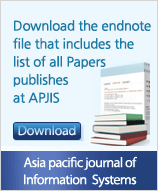The Journal for Information Professionals
Asia Pacific Journal of Information Systems (APJIS), a Scopus and ABDC indexed journal, is a
flagship journal of the information systems (IS) field in the Asia Pacific region.
ISSN 2288-5404 (Print) / ISSN 2288-6818 (Online)
Editor : Seung Hyun Kim
Past Issue
| Date | September 2013 |
|---|---|
| Vol. No. | Vol. 23 No. 3 |
| DOI | http://dx.doi.org/10.14329/apjis.2013.23.3.025 |
| Page | 25~53 |
| Title | The Effects of the Computer Aided Innovation Capabilities on the R&D Capabilities:Focusing on the SMEs of Korea |
| Author | Jae Eok Shim, Moo Jang Byeon, Hyo Gon Moon, Jay in Oh |
| Keyword | Organizational Environment, CAI(Computer Aided Innovation), CAI Capability, R&D Capability, Dynamic Capability, Organizational Capability, Process Capability, Collaboration Capability |
| Abstract | This study analyzes the effect of Computer Aided Innovation (CAI) to improve R&D Capabilities empirically. Survey was distributed by e-mail and Google Docs, targeting CTO of 235 SMEs. 142 surveys were returned back (rate of return 60.4%) companies. Survey results 119 companies (83.8%) which are effective samples except no-response, insincere response, estimated value, etc. were used for statistics analysis. Companies with less than 50billion KRW sales of entire researched companies occupy 76.5% in terms of sample traits. Companies with less than 300 employees occupy 83.2%. In terms of the type of company business Partners (called partners with big companies hereunder) who work with big companies for business occupy 68.1%. SMEs based on their own business (called independent small companies) appear to occupy 31.9%. The present status of holding IT system according to traits of company business was classified into partners with big companies versus independent SMEs. The present status of ERP is 18.5% to 34.5%. QMS is 11.8% to 9.2%. And PLM (Product Life-cycle Management) is 6.7% to 2.5%. The holding of 3D CAD is 47.1% to 21%. IT system-holding and its application of independent SMEs seemed very vulnerable, compared with partner companies of big companies. This study is comprised of IT infra and IT Utilization as CAI capacity factors which are independent variables. factors of R&D capabilities which are independent variables are organization capability, process capability, HR capability, technology-accumulating capability, and internal/external collaboration capability.The highest average value of variables was 4.24 in organization capability 2. The lowest average value was 3.01 in IT infra which makes users access to data and information in other areas and use them with ease when required during new product development. It seems that the inferior environment of IT infra of general SMEs is reflected in CAI itself. In order to review the validity used to measure variables, Factors have been analyzed. 7 factors which have over 1.0 pure value of their dependent and independent variables were extracted. These factors appear to explain 71.167% in total of total variances. From the result of factor analysis about measurable variables in this study, reliability of each item was checked by Cronbachs Alpha coefficient. All measurable factors at least over 0.611 seemed to acquire reliability. Next, correlation has been done to explain certain phenomenon by correlation analysis between variables. As R&D capabilities factors which are arranged as dependent variables, organization capability, process capability, HR capability, technology-accumulating capability, and internal/external collaboration capability turned out that they acquire significant correlation at 99% reliability level in all variables of IT infra and IT Utilization which are independent variables. In addition, correlation coefficient between each factor is less than 0.8, which proves that the validity of this study judgement has been acquired. The pair with the highest coefficient had 0.628 for IT utilization and technology-accumulating capability.Regression model which can estimate independent variables was used in this study under the hypothesis that there is linear relation between independent variables and dependent variables so as to identify CAI capabilitys impact factors on R&D. The total explanations of IT infra among CAI capability for independent variables such as organization capability, process capability, human resources capability, technology-accumulat-ing capability, and collaboration capability are 10.3%, 7%, 11.9%, 30.9%, and 10.5% respectively. IT Utilization exposes comprehensively low explanatory capability with 12.4%, 5.9%, 11.1%, 38.9%, and 13.4% for organization capability, process capability, human resources capability, technology-accumulating capability, and collabo-ration capability respectively. However, both factors of independent variables expose very high explanatory capability relatively for technology-accumulating capability among independent variable. Regression formula which is comprised of independent variables and dependent variables are all significant (P < 0.005). The suitability of regression model seems high. When the results of test for dependent variables and independent variables are estimated, the hypothesis of 10 different factors appeared all significant in regression analysis model coefficient (P < 0.01) which is estimated to affect in the hypothesis. As a result of liner regression analysis between two independent variables drawn by influence factor analysis for R&D capability and R&D capability. IT infra and IT Utilization which are CAI capability factors has positive correlation to organization capability, process capability, human resources capability, technology-accumulating capability, and collaboration capability with inside and outside which are dependent variables,, R&D capability factors. It was identified as a significant factor which affects R&D capability. However, considering adjustable variables, a big gap is found, compared to entire company. First of all, in case of partner companies with big companies, in IT infra as CAI capability, organization capability, process capability, human resources capability, and technology capability out of R&D capacities seems to have positive correlation. However, collaboration capability appeared insignificance. IT utilization which is a CAI capability factor seemed to have positive relation to organization capability, process capability, human resources capability, and internal/external collaboration capability just as those of entire companies.Next, by analyzing independent types of SMEs as an adjustable variable, very different results were found those of entire companies or partner companies with big companies. First of all, all factors in IT infra except technology-accumulating capability were rejected. IT utilization was rejected except technology-accumu-lating capability and collaboration capability. Comprehending the above adjustable variables, the following results were drawn in this study. First, in case of big companies or partner companies with big companies, IT infra and IT utilization affect improving R&D Capabilities positively. It was because most of big companies encourage innovation by using IT utilization and IT infra building over certain level to their partner companies. Second, in all companies, IT infra and IT utilization as CAI capability affect improving technology-accumulating capability positively at least as R&D capability factor. The most of factor explanation is low at around 10%. However, technology-accumulating capability is rather high around 25.6% to 38.4%. It was found that CAI capability contributes to technology-accumulating capability highly. Companies shouldnt consider IT infra and IT utilization as a simple product developing tool in R&D section. However, they have to consider to use them as a management innovating strategy tool which proceeds entire-company management innovation centered in new product development. Not only the improvement of technology-accumulating capability in department of R&D . Centered in new product development, it has to be used as original management innovative strategy which proceeds entire company management innovation. It suggests that it can be a method to improve technology-accumulating capability in R&D section and Dynamic capability to acquire sustainable competitive advantage. |
Home l Site Map l Abstracting/Indexing l FAQ l Publisher l Contact Us l Admin Login
© 2013 The Korean Society of Management Information Systems. All rights reserved.




















